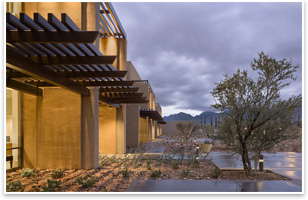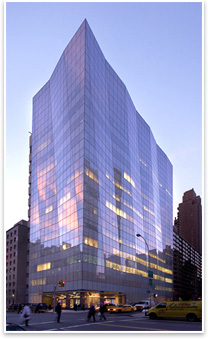Academy for Health Honors Four with AIA National Healthcare Design Awards
Summary: The AIA Academy of Architecture for Health (AAH) on August 19 announced the recipients of its inaugural AIA National Healthcare Design Awards program. Continuing the AIA’s legacy of celebrating outstanding works of contemporary architects, the new awards program showcases the best of health-care building design and health design-oriented research.
“Collectively, the winning projects exhibit conceptual strength and address aesthetic, civic, urban, and social concerns, as well as the requisite programmatic functional and sustainability concerns of a health-care facility,” said Jury Chair Dan Noble, FAIA. “Individually, the specific design solutions create ideal healing environments for patients, staff, and visitors while contributing to an improvement in the urban landscape in which they are located.”
2008 AIA National Healthcare Design Awards recipients
 Project: Cha Women & Children’s Hospital Project: Cha Women & Children’s Hospital
Location: Bun Dang GuSeongNam, South Korea
Architect: KMD Architects
This new hospital, planned to maximize the benefits of natural light while providing access to outdoor areas, is among the first in Korea to offer a full array of advances from the U.S., such as labor and delivery room, water-birthing, and participation by family members in the birthing process; features that are taken for granted stateside. The facility was designed to maximize the benefits of natural light as well as to provide patient, visitor, and staff access to the outdoors from public areas. The hospital celebrates high technology but tempers it through the inclusion of elements from traditional Korean architecture, such as wood, plants, water features, and organic forms contrasting with glass, aluminum, and stainless steel. Both inside and out, the design focus is on creating sleek, uncluttered surfaces to offer patients and visitors a respite from the surrounding neighborhood’s visual noise.
 Project: The Peter and Paula Fasseas Cancer Clinic at University Medical Center North Project: The Peter and Paula Fasseas Cancer Clinic at University Medical Center North
Location: Tucson
Architect: CO Architects
Removed from the institutional setting of the acute care hospital, this comprehensive cancer clinic invokes the power of the desert landscape to define it as a place of inspiration and healing. The visual and physical access to the outdoors provides patients and staff at this intimately scaled facility with a connection to the healing power of nature. Through the integration of the three courtyards into the building’s organization, as well as the extensive natural desert landscape and the distant views of the mountains, Tucson’s rugged natural beauty has been incorporated into the patient’s and staff’s daily experience. The infusion therapy and exam rooms are organized around the courts and are all provided with restorative views. The waiting rooms, public spaces, and corridors look out toward the garden and the distant mountains. The sandstone wall at the main entrance is pulled away from the building, creating a shaded area that serves as a “porch.” The trellises on the east and west sides of the building are important shade elements that give light and shadow to the building and also visually extend the inside towards the outside, integrating the interior and exterior.
 Project: Shenzhen Third People's Hospital Project: Shenzhen Third People's Hospital
Location: Shenzhen, China
Architect: TRO Jung|Brannen
The design team created a hospital that blended traditional Chinese forms with Western technology. The design solution is a linear-spined campus with a series of narrow buildings that are curved to capture sunlight and channel the winds. Although the buildings will have internal mechanical systems consistent with those found in U.S. hospitals to halt the spread of infection, the campus organization locates infectious patients downwind and offers them the natural healing power of sunlight and serene garden views while assuaging the fear of infection, a major concern in Chinese hospitals. To further fight the spread of infection, the campus is divided into three zones. The infectious zone has four buildings for infectious diseases, including liver and hepatitis, viruses, tuberculosis, and severe respiratory diseases. The semi-infectious zone contains diagnostic treatment and outpatient clinic space and a research building, while the non-infectious zone includes administrative offices and staff housing. No internal connections exist among these three zones.
 Project: Weill Greenberg Center Project: Weill Greenberg Center
Location: New York City
Architect: Polshek Partnership Architects/Ballinger
Inspired by the tranquility of a spa environment, the design of this world-class facility optimizes the patient experience to promote health and healing and reinforces the institution’s state-of-the-art clinical services. Design features that contribute to the creation of a calm and effective patient experience include: diffuse natural light, the use of water both for its aural and visual features, and natural materials for their tactile, visual, and associative characteristics. Sheathed in a white ceramic-fritted, facetted glass curtain wall and selected for its translucent qualities and experiential richness, the 330,000-square-foot, 15-story building symbolizes the progressive identity of the institution. From the interior, the translucent skin subdues the hustle and bustle of the city. The project’s singular identity and its being the first of the college’s clinical facilities on the west side of York Avenue distinguish it from the clinical image of New York Hospital. Throughout the design and construction process, the building was evaluated for its contribution to evidence-based design.
| 

 Project:
Project: Project:
Project: Project:
Project: Project:
Project: